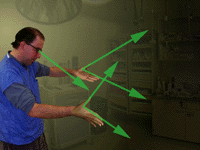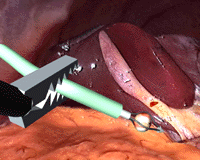


Virtual Prototyping of Medical Robotic Interfaces main page
Virtual Prototyping of Medical Robotic Interfaces

Minimally invasive laprosopic surgery and micro-surgery are basically interface problems. The surgeon is outside of the body trying to interact with tissue that is inside the body and at smaller scales. Virtual interface technology combined with robotic master/slave manipulators can potentially re-map this relationship between the surgeon and patient, and thereby provide additional degrees of freedom to the surgeons movements and senses, and close the gap between inside and outside, large and small.
In addition, virtual prototyping and simulation can be used to try out various intrface and mechanical robot designapproaches proir to construction and therefore reduce the time and cost of a complex engineering design cycle.

We propose to apply virtual reality technology to the design and implementation of Medical Robotic Interfaces. A system for human controlled, robotically performed surgery consists of two components: a master and a slave. The robotic slave device that performs the surgery on the patient, and a human interface master device that controls the robotic slave. The master/slave configuration essentially provides an interface between the surgeon and the patients anatomy. The interface maps the surgeons movements and senses to the instruments.
The more accurate, efficient and intuitive the interface the better. A robotic system can potentially re-map the conventional surgical interface to increase accuracy, efficiency and intuitiveness.
Virtual Reality technology applied to the master component can assist in the interface re-mapping by providing greater immersion as well as scaling of force and size.

Motivation
Human Controlled Robot Manipulators can provide numerous advantages in performing surgical tasks, especially in micro-surgery and minimally invasive surgical procedures. In micro-surgery, robots can potentially provide high procession by performing small manipulations that cannot be performed by hand. In minimally invasive procedures, robots can provide additional degrees of freedom and a more intuitive user interface than conventional laproscopic instruments that require inverted hand movements outside of the patient.
Contacts
Peter Oppenheimer <peter![]() hitl.washington.edu>
hitl.washington.edu>